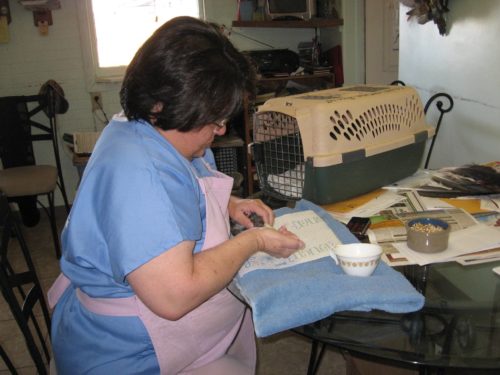
Warmer temperatures mean its baby bird season, which is a busy time for Second Chance Wildlife Rehabilitation in Carbonville. The non-profit organization begins to receive telephone calls from citizens that they have found a baby bird that has either fallen out of their nest or has been abandoned by their mother
“I get a lot of these calls every day, and so a lot of times people will hear them and they know that they’re in a wall or a soffit or something like that. If they can I just tell them to leave it there. Normally, from a time a bird lays its eggs, to the time that the babies are gone it’s less than a month,” said Facilitator, Brenda Pappas. Citizens are strongly encouraged to leave that area alone during the incubation period. Any disturbances to the birds can affect the outcome of incubation and/or lead adult birds to abandon their nests.
“Sometimes if they go to the ground, they’ve fallen, then we have to know is it a fledging or is it truly a bird that should still be in the nest. Those birds need to be put back if possible, and no, don’t believe, oh but if I touch it the mom will reject it, that is an old wife’s tale, there’s absolutely no truth to that. So put them back if you can,” stated Pappas. It’s illegal to remove or destroy any active nest from any native bird species. An active nest is characterized as a nest with eggs or brooding adults in it.
If the nest is destroyed and baby birds are falling out of nests you can help, as Pappas explains, “Creating fake nests to help them or like Dave and I were talking about a little hammock under a nest, if they fall, the parents could still get to the baby. Where the baby is off the ground and safe, but keep in mind, you know, if that little baby bird has fallen 10 – 20 feet, I don’t care what it looks like to you, the chances are things are not good. That’s pretty big fall for a little bird. We will still try to help it, but the chances of survival are not good.” Any individuals that come upon a nest that has been blown down from the wind or ransacked by a predator or just looks flattened with no sign of the birds, it’s most likely they prospered. If a nest is discovered to be torn up, facing upside down with broken eggs, then they probably failed.
Second Chance Wildlife Rehabilitation is a state and federally-permitted wildlife rehabilitation facility in Eastern Utah serving many counties throughout Utah. They are a non-profit organization where 100 percent of its funds go directly to the care and needs of wildlife. The organization is always looking for individuals to volunteer, especially those that specialize in carpentry or electrical work to help with the ongoing construction of enclosures on the premises.
If you would like more information on volunteering call (435) 650-3441 or to learn more about Second Chance Wildlife Rehabilitation visit their Facebook page.
